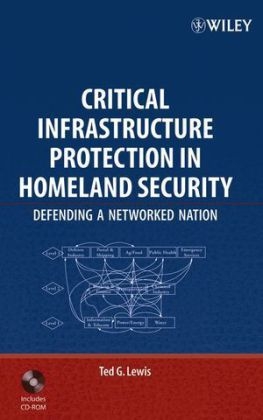
Critical Infrastructure Protection in Homeland Security
Defending a Networked Nation
Seiten
2006
Wiley-Blackwell (an imprint of John Wiley & Sons Ltd) (Verlag)
978-0-471-78628-3 (ISBN)
Wiley-Blackwell (an imprint of John Wiley & Sons Ltd) (Verlag)
978-0-471-78628-3 (ISBN)
- Titel ist leider vergriffen;
keine Neuauflage - Artikel merken
Zu diesem Artikel existiert eine Nachauflage
Critical Infrastructure Protection in Homeland Security: Defending a Networked Nation is a definitive textbook on critical infrastructure protection.
A scientific approach to the new field of critical infrastructure protection This book offers a unique scientific approach to the new field of critical infrastructure protection: it uses network theory, optimization theory, and simulation software to analyze and understand how infrastructure sectors evolve, where they are vulnerable, and how they can best be protected. The author demonstrates that infrastructure sectors as diverse as water, power, energy, telecommunications, and the Internet have remarkably similar structures. This observation leads to a rigorous approach to vulnerability analysis in all of these sectors. The analyst can then decide the best way to allocate limited funds to minimize risk, regardless of industry sector. The key question addressed in this timely book is: What should be protected and how? The author proposes that the answer lies in allocating a nation's scarce resources to the most critical components of each infra-structure--the so-called critical nodes. Using network theory as a foundation, readers learn how to identifya small handful of critical nodes and then allocate resources to reduce or eliminate risk across the entire sector.
A comprehensive set of electronic media is provided on a CD-ROM in the back of the book that supports in-class and self-tutored instruction. Students can copy these professionally produced audio-video lectures onto a PC (Microsoft Windows(r) and Apple Macintosh(r) compatible) for repeated viewing at their own pace. Another unique feature of the book is the open-source software for demonstrating concepts and streamlining the math needed for vulnerability analysis. Updates, as well as a discussion forum, are available from www.CHDS.us. This book is essential for all corporate, government agency, and military professionals tasked with assessingvulnerability and developing and implementing protection systems. In addition, the book is recommended for upper-level undergraduate and graduate students studying national security, computing, and other disciplines where infrastructure security is an issue.
A scientific approach to the new field of critical infrastructure protection This book offers a unique scientific approach to the new field of critical infrastructure protection: it uses network theory, optimization theory, and simulation software to analyze and understand how infrastructure sectors evolve, where they are vulnerable, and how they can best be protected. The author demonstrates that infrastructure sectors as diverse as water, power, energy, telecommunications, and the Internet have remarkably similar structures. This observation leads to a rigorous approach to vulnerability analysis in all of these sectors. The analyst can then decide the best way to allocate limited funds to minimize risk, regardless of industry sector. The key question addressed in this timely book is: What should be protected and how? The author proposes that the answer lies in allocating a nation's scarce resources to the most critical components of each infra-structure--the so-called critical nodes. Using network theory as a foundation, readers learn how to identifya small handful of critical nodes and then allocate resources to reduce or eliminate risk across the entire sector.
A comprehensive set of electronic media is provided on a CD-ROM in the back of the book that supports in-class and self-tutored instruction. Students can copy these professionally produced audio-video lectures onto a PC (Microsoft Windows(r) and Apple Macintosh(r) compatible) for repeated viewing at their own pace. Another unique feature of the book is the open-source software for demonstrating concepts and streamlining the math needed for vulnerability analysis. Updates, as well as a discussion forum, are available from www.CHDS.us. This book is essential for all corporate, government agency, and military professionals tasked with assessingvulnerability and developing and implementing protection systems. In addition, the book is recommended for upper-level undergraduate and graduate students studying national security, computing, and other disciplines where infrastructure security is an issue.
TED G. LEWIS, PHD, is Professor of Computer Science and Academic Associate of the Homeland Defense and Security curriculum at the Naval Postgraduate School. Dr. Lewis is the former senior vice president of Digital Development for Eastman Kodak.
Preface. About the Author. 1. Strategy. 2. Origins. 3. Challenges. 4. Networks. 5. Vulnerability Analysis. 6. Risk Analysis. 7. Water. 8. SCADA. 9. Power. 10. Energy. 11. Telecommunications. 12. Internet. 13. Cyber-Threats. 14. Cyber-Security.
| Erscheint lt. Verlag | 23.5.2006 |
|---|---|
| Zusatzinfo | Illustrations, maps |
| Verlagsort | Chicester |
| Sprache | englisch |
| Maße | 167 x 244 mm |
| Gewicht | 859 g |
| Einbandart | gebunden |
| Themenwelt | Informatik ► Netzwerke ► Sicherheit / Firewall |
| Informatik ► Theorie / Studium ► Kryptologie | |
| Naturwissenschaften ► Chemie | |
| Sozialwissenschaften ► Politik / Verwaltung | |
| ISBN-10 | 0-471-78628-4 / 0471786284 |
| ISBN-13 | 978-0-471-78628-3 / 9780471786283 |
| Zustand | Neuware |
| Informationen gemäß Produktsicherheitsverordnung (GPSR) | |
| Haben Sie eine Frage zum Produkt? |
Mehr entdecken
aus dem Bereich
aus dem Bereich
Das Lehrbuch für Konzepte, Prinzipien, Mechanismen, Architekturen und …
Buch | Softcover (2022)
Springer Vieweg (Verlag)
CHF 53,15
Management der Informationssicherheit und Vorbereitung auf die …
Buch (2024)
Carl Hanser (Verlag)
CHF 97,95
Lehrbuch für Prüfung und Praxis
Buch | Softcover (2023)
Springer Fachmedien Wiesbaden GmbH (Verlag)
CHF 27,95



